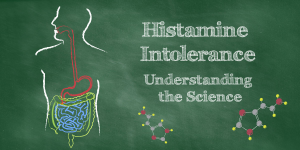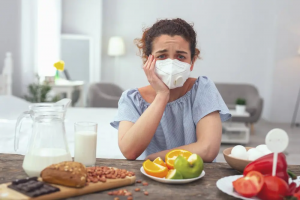 Many people turn to a wholefoods diet in a bid to manage a variety of health concerns such as irritable bowel syndrome (IBS), chronic sinusitis, anxiety, headaches or fatigue. However some find little improvement in their symptoms and some, in fact, may even get worse. They may also find certain medications prescribed to help with these issues may instead aggravate them, which can be extremely frustrating.
Many people turn to a wholefoods diet in a bid to manage a variety of health concerns such as irritable bowel syndrome (IBS), chronic sinusitis, anxiety, headaches or fatigue. However some find little improvement in their symptoms and some, in fact, may even get worse. They may also find certain medications prescribed to help with these issues may instead aggravate them, which can be extremely frustrating.
This is a scenario that often occurs for the many sufferers of histamine intolerance (HIT), a condition that is frequently misdiagnosed though one that is becoming more prevalent. Currently, it is thought that roughly 1% of the population could be histamine intolerant with approximately 80% of those affected being middle-aged, with females being more susceptible than males.
What is Histamine Intolerance?
HIT occurs when the body is unable to breakdown histamine effectively because of a defect in one of two enzymes – diamine oxidase (DAO) and histamine N-methyltransferase (HNMT). DAO is found in the intestine and is the primary enzyme for the metabolism of histamine in foods, while HNMT is the primary enzyme for the degradation of histamine in intracellular tissue, such as the bronchial epithelium. When DAO or HNMT enzyme activity is deficient, histamine is reabsorbed in the intestines and carried through the bloodstream in its active form, causing an excess of histamine in the body that results in an array of symptoms that can mimic an allergic reaction.
Symptoms Associated with HIT
Unlike other food intolerance’s and allergies, the issue with HIT is cumulative. Reactions are not always immediate, as smaller amounts of histamine are unlikely to cause any negative effects, making the trigger difficult to pinpoint.
Symptoms may present differently from person to person and may present across multiple systems, with the digestive, respiratory, cardiac, and nervous systems being the most commonly affected. Some of the most prevalent symptoms of histamine intolerance include:
- Abdominal pain, Abnormal periods, Anxiety
- Asthma, Breathing difficulties (e.g. wheezing), Chest pain
- Confusion, Conjunctivitis, Diarrhoea
- Dizzy spells, Excess mucous, Fatigue
- Flushing, Headaches, Hives
- Hypertension, Hypotension, Insomnia
- Irritability, Nausea and/or vomiting, Nasal congestion
- Night sweats, Panic attacks, Pruritus
- Reflux, Sinus problems, Sneezing, often in fits
- Tachycardia, Temperature dysregulation, Tissue swelling and inflammation
 What Causes HIT?
What Causes HIT?
Factors that contribute to the onset of HIT are many and varied and may include:
- Deficiencies or dysfunction of DAO, or HNMT. This is usually the result of a genetic fault although gut dysbiosis, certain medications and certain foods can also block the function of all these enzymes.
- Nutrient deficiencies such as copper, vitamin C vitamin B6 or zinc (although some suggest this is controversial).
- Nutrient excesses like histidine, or a protein excess in general.
- Taking medications that may block DAO or release excess histamine such as analgesics, antibiotics, antidepressants, antacids, diuretics and non-steroidal anti-inflammatories (NSAIDs).
- Excessive histamine consumption (avocado, dried fruits, eggplant, fermented foods, high protein intake, aged foods, leftovers).
- Excessive consumption of foods that trigger the release of histamine (citrus, bananas, pork, egg white, chocolate, crustaceans, spinach).
- Hormonal imbalance (insufficiency or excess); an increase in oestrogen levels in particular make women more susceptible to HIT.
- High levels of stress place high nutrient demands on the body.
- Gut dysbiosis, IBS or inflammatory bowel disease (IBD).
- Presence of pathogens (many of which produce histamine or block methylation).
How is HIT Diagnosed?
The gold standard approach for the diagnosis of HIT is a low histamine diet for one month, followed by slow reintroduction of medium to high histamine foods. If symptoms improve markedly during the elimination period, HIT is the likely diagnosis.
HIT testing has not been widely available in Australia and, until recently, very few laboratories offered anything but urine testing. More recently, blood tests have become available which assay IgG and IgE mediated food allergy and intolerance. In addition, genetic testing can provide information regarding any genetic defects associated with histamine metabolism that may be contributing to the condition.
Which foods Should be Avoided on a Histamine Diet?
Certain foods contain high levels of histamines while others have a histamine liberating effect. When undertaking a low histamine diet both groups of foods need to be avoided, given the result is essentially the same, being that excess histamines in the body causing a histamine reaction.
 Foods High In Histamine
Foods High In Histamine
- Additives and preservatives
- Alcohol (particularly beer and wine)
- Avocado
- Coffee and tea
- Cured and smoked meats and seafood
- Dried fruits
- Eggplant
- Fermented foods (cheese, kimchi, kombucha, sauerkraut, yoghurt)
- Foods high in protein
- Vinegars and vinegar containing foods (e.g. pickles and mustard)
Leftovers can also cause an excessive reaction, as histamine content increases with the maturation of food.
Foods that Liberate Histamine
- Bananas
- Chocolate / cacao / carob
- Citrus fruits
- Crustaceans
- Egg white
- Most nuts and seeds (except macadamias)
- Paw paw
- Pineapple
- Pork
- Spinach
- Strawberries
- Tomatoes and tomato-based products
Certain medications may also block DAO activity or liberate histamine, both of which will cause a histamine reaction. Examples include antidepressants, NSAIDs or radio-contrast agents used for x-rays.
Naturopathic Approach to the Treatment of HIT
The naturopathic approach to managing HIT considers the numerous contributing factors and suggested treatment may include:
- Management of gut dysbiosis (most important).
- A low histamine elimination diet for one month, with slow reintroduction of higher histamine foods to test for tolerance.
- Balancing hormones and addressing any associated conditions such as adrenal fatigue or high stress.
- Focusing on associated methylation issues, where genetic factors (e.g. MTHFR) are contributing, and amending or adding supplementation as required.
- Herbal medicines such as Albizia lebbek (albizia) and Ocimum sanctum (holy basil) have been shown to stabilise mast cell activity, while Scutellaria baicalensis (baical skullcap) and Nigella sativa (black cumin) have been shown to inhibit the release of histamine from mast cells. To date, limited clinical trials showing the effects of these herbs have been completed and some supporting evidence is from animal studies.
- General anti-inflammatory and immune support is also useful
- Nutrient supplementation with some of the most important being:
- quercetin (antihistamine and anti-inflammatory properties)
- vitamin B6 (increases DAO activity)
- vitamin C (increases histamine metabolism and breakdown)
- vitamin E (may decrease mast cell activation)
- magnesium sulfate (inhibits the release of histamines).
- Specific probiotic strains such as Lactobacillus reuteri, Lactobacillus plantarum, Lactobacillus shirota, Lactobacillus rhamnosus GG, Lactobacillus rhamnosus Lc705 and a combination of Bifidobacterium longum and Bifidobacterium infantis have also been shown to have positive effects by working as anti-histamines and/or mast cell stabilisers, though additional clinical trials in humans are needed
- DAO enzyme supplementation is also often suggested, however the Therapeutic Goods Administration has not yet approved these for use in Australia. It is also worth considering that use of DAO enzymes means the root cause of the issue is not being addressed.
TOP 5 THINGS TO KNOW ABOUT HIT
- Because of the vast array of symptoms involved in HIT, it can be difficult to detect and is often misdiagnosed for conditions such as anxiety disorder, IBS, chronic sinusitis and even candida overgrowth.
- A ‘healthy diet’ may cause severe aggravation of HIT as many natural and wholesome foods such as bananas, avocado, spinach and fermented foods are extremely high in histamines or liberate histamines.
- Gut dysbiosis is one of the key mechanisms in HIT so working with a naturopath to restore optimal gut function is essential.
- Both physical and emotional stress can significantly increase histamine levels in the body, so stress management is a fundamental aspect of treatment.
- Long-term use of anti-histamines can lead to HIT, so it’s best to try and address or manage the cause as opposed to masking the symptoms.
Leave a Reply